
26 minute read
AUST CHAMPS CARNIVAL
Tassie East Coast Escape
Blair Trewin
Grant Bluett (ACT) won M21E at the Highwayman’s Classic NOL event.
AFTER a warm-up at the Lea, south of Hobart, on the Saturday, the serious business of the carnival got under way at the Tasmanian Championships at Pittwater Dunes. With Stockton and Cantara now too thick to be in regular use, Pittwater is the one sand-dune area used for high-level competition in Australia, and provided the field with a test different to what most see on any sort of a regular basis.
Given the unusual nature of the terrain, it was not surprising that there were a few unusual results, with the open classes providing two of them. Grant Bluett and Hanny Allston went into the events as warm favourites, but both made significant errors at various stages of the event, and both missed the placings. That opened the way for others, and in M21E the remaining places in the top seven were filled by three pairs who were all together for significant parts of the course: Rob Preston and Bruce Arthur, Ben Rattray and Peter Preston, and Rob Jessop and Blair Trewin. Jessop led at two-thirds distance but lost three minutes on the highly complex open dunes at the end of the peninsula, opening the way for Preston to take the lead for the first time and get a reward for a consistent season. Rattray was second, and Arthur third.
The leading women were more consistent, in fact remarkably so on such a technical area. Anna Danielsson, whose prominent Australian results had hitherto been confined to sprint events, found the complex flat terrain more to her liking than most others in this country. She took an early lead of about 30secs over Danielle Winslow and the margin stayed remarkably close to that all the way; Winslow led briefly by one second and was never more than a minute behind, but Danielsson was the leader in the end. Allston, after early problems, looked like she might at least challenge Tracy Bluett for third, but a late mistake ended any chance of that.
The junior elite classes had their first official airing. Ainsley Cavanagh got her carnival off to a very impressive start with a comprehensive six-minute win in W17-20E. She was already well clear of the field by the third control, and although Zebedy Hallett pegged her back to cut the margin from six minutes to three at one stage, she lost all of that again at 13, just holding off Heather Harding for second. M17-20E introduced a new face to the Australian Orienteering scene. Timo Sild carries a considerable pedigree – his father is Estonian WOC medallist Sixten – but other foreign juniors with equally impressive credentials have come out on exchange in the past and failed to set the world on fire, so his win came as something of a surprise. His nearest competition fell away when Simon Uppill failed to register at a control, while Nick Andrewartha, in his first year as an M18, looked to have taken a step up when he recovered from being six minutes down by 6 to take second place.
As is often the case, the cream rose to the top in the technical terrain, with particularly impressive runs being recorded by the likes of Paul Pacque (10min ahead in M50), Geoff Peck (4min ahead in M55), Jenny Bourne (4min ahead of Carolyn Jackson in W45), and, less predictably, Judy Allison, who had a career-best performance with an 11min win in W55. The New Zealand juniors also showed what they have to offer. They went 1-2 in M14 (Toby Scott and Scott McDonald) and W14 (Kate Morrison and Jaime Goodwin), and would have done likewise in M16 had Thomas Reynolds and Simon Jager not both lost four minutes on the second-last control, letting Matt Barratt through for a home-state triumph.
National League Round 12, Sandstone Valleys, 27 September
NORMAL service was resumed when Grant Bluett and Hanny Allston won the midweek National League round easily over the hills and rocks of Sandstone Valleys. Allston was a particularly comfortable winner, running away from the field on terrain which was well suited to her physical strength. Anna Danielsson looked like she might be the closest challenger but lost four minutes at 8, leaving Julia Davies to get 2nd in a close contest with Tracy Bluett and Clare Hawthorne.
Grant Bluett got his biggest jump on the field when he took a route choice off the map and around a big hill on the long sixth leg, but he was already in front before that. His lead grew to nearly four minutes before he lost half of it on 10, but he still had more than enough in hand to hold off Ben Rattray, who came 2nd for the second time in three days. Rob Preston just held off his younger brother for 3rd.
Louis Elson and Erin Post impressed most amongst the juniors, with consistent winning runs which would have been enough to place both in the top six on the senior courses. Simon Uppill, Ryan Smyth and Kellie Whitfield were others to achieve the first target of any junior in this event – beating all the Schools Championships competitors.

Wendy Read (QLD) during the Highwayman’s Classic NOL event.

Chris Naunton (VIC) was 5th in M17-20E at the Sprint Champs.
Tract Bluett (NSW) 3rd at the Sprint Champs.
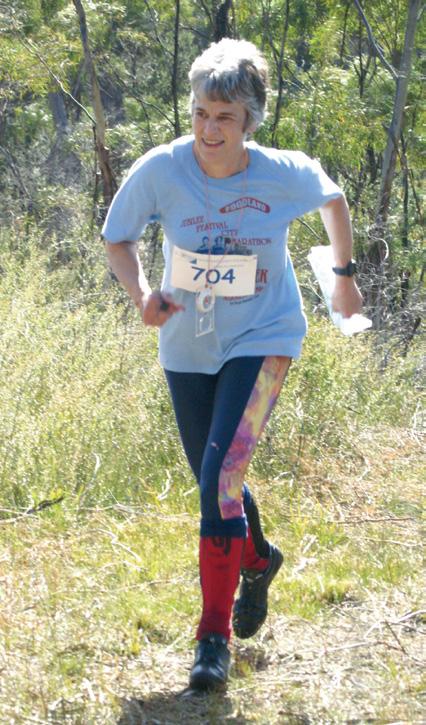
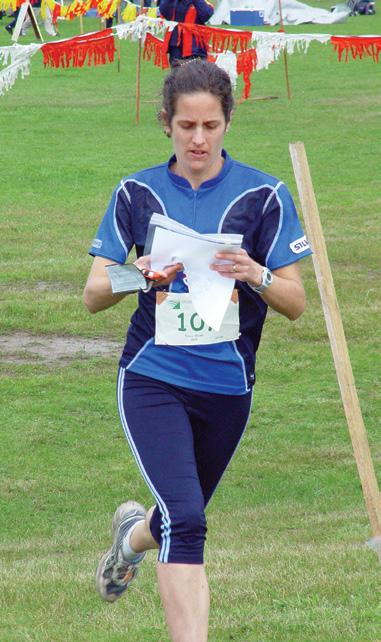

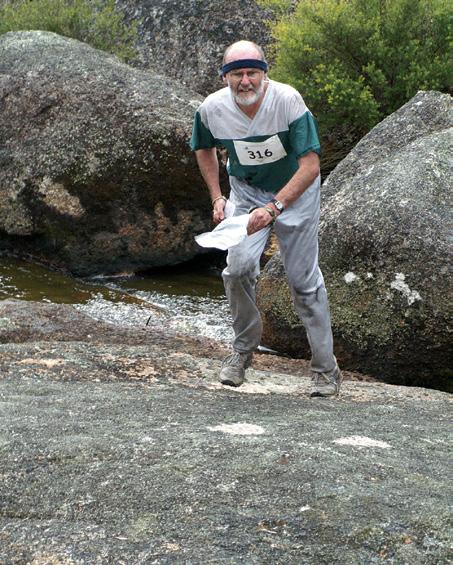
Mary Enter (VIC) was part of the winning W55 Relay team with Libby Meeking and Kathy Liley.
Back on his feet again, MTB-O champ, Adrian Jackson was only just back from the World MTBO Champs in Slovakia. Dave Lotty (NSW) negotiates the water and boulders on his way to 2nd place in M60A at the Aust Long Champs.
Australian Schools Championships & Southern Cross Junior Challenge, Sandstone Valleys, 27-28 September
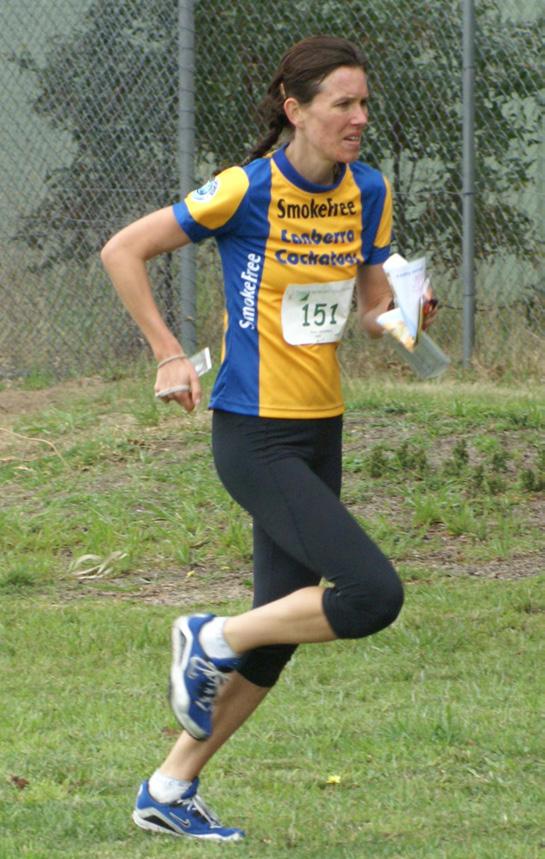
QUEENSLAND won the Australian Schools Championships outright for the first time. They had got reasonably close in 2004, losing their chance after a relay mix-up, but they made no mistake in 2005. They brought a team with a depth reminiscent of the NSW teams of the mid to late 1990’s, with no weak age groups, and they never looked like losing. It was all over with a couple of relays still to be decided. Their only previous taste of victory had been in 1991, when they shared the title with the ACT.
New Zealand were even more dominant in the Southern Cross Junior Challenge. The only reason 2003 and 2004 had been close had been because their senior boys were weak, and with that remedied in 2005 they were almost untouchable. Queensland were the only state which managed to take even a single point off them.
The individual titles were split two each between Queensland and New Zealand. For the first half of the senior boys’ race, it looked like the winner might be someone with connections to both camps, Daniel Stott – a New Zealander who has moved to Queensland. He broke away from the field on the long and tough sixth leg, but started to make mistakes in the more technical second half, and lost five minutes at 11 to end his hopes. That left last starter James Sheldon in the best position to take advantage, despite losing two minutes himself at 10, and while his lead dropped to 42secs at 12, that was as close as it got. Rob Fell had been the clubhouse leader almost all day before being beaten at the last opportunity, but still had a very solid run for second place, whilst Simon Jager and Jack Vincent were the leading New Zealanders in third and fourth, both recovering from poor sixth legs.
The senior girls were close for the first half, although one contender was eliminated when Sarah Dunnage lost four minutes at the first control. Only 90secs covered the top four at halfway, but Lizzie Ingham, who was in fourth at that stage, took the lead for the first time on the long and steep ninth leg, and held it all the way thereafter. Kate Rea made it a New Zealand quinella, whilst Heather Harding and Clare Brownridge were the best of the locals.
For most of the way the junior boys race looked to be a two-way contest between Scott McDonald, a formidably fast New Zealand M14 who has already won major events at M18 level, and Leon Keely, hitherto most notable for being a Victorian cross-country representative (and Jim Russell’s nephew). With three controls to go they were only seconds apart, but Keely’s race fell apart from there, and three minutes lost at the second-last saw him plunge out of the placings altogether. Toby Scott, who had been consistent throughout without ever really looking like beating his compatriot, came through for second, whilst Lachlan Dow was the leading Australian in third.
The junior girls saw a similar story, with two clear leaders through the first half, one of whom sustained it to the finish and one of whom didn’t. This time the protagonists were Krystal Neumann, who had shown ample evidence of her potential by blowing the W14 field away at Easter 2004, and Catherine Hewitt, one of the best chances for the home state. Hewitt lost four minutes at 9, and from there Neumann won comfortably. Rachel Goodwin gave the New Zealanders yet another medal with a solid second, with Claire Darvodelsky in third place.
Like the individual events, the relay titles were split two-all between Queensland and New Zealand. The senior boys provided the closest race of the four. On a day which was something of a running race, five teams were within two minutes of the lead after the first leg, but by the end of the second leg that had been reduced to a two-way contest between Queensland and New Zealand. New Zealand looked clear favourites from there with Simon Jager up against Simon Mee, the Queenslanders having led off with Daniel Stott and James Sheldon, but Mee had his best race of the week to keep the pressure on Jager, which meant he was there to pick up the pieces when Jager made a significant error in mid-leg (and full view of the spectators). That was enough to give the win to Queensland.
New Zealand were predictably dominant in the senior girls, extending their lead throughout the day to win by six minutes in the end. The main interest was in the battle for second between Victoria, the ACT and Queensland, in which the three leading Australians from the individual faced each other on the last leg. Queensland led at the start of the leg, but it came down to a battle between Clare Brownridge and Heather Harding, with Brownridge just holding off Harding to give Victoria the result.
There was something of an upset in the junior boys (admittedly in a week where any loss by a New Zealand team constituted an upset). Queensland’s Gary Flynn surprised by giving his team a five-minute lead over the New Zealanders after the first leg, and although Scott McDonald came back hard on the last leg with the day’s fastest time, Oliver Crosato had more than enough in hand to hold on. McDonald’s late charge was enough to see the NZ team into second, just ahead of the Tasmanians.
Claire Darvodelsky brought NSW in together with New Zealand after the first leg of the junior girls, but New Zealand was never challenged thereafter and won comfortably. NSW were the next best, although they got a scare from Tasmania on the last leg when Catherine Hewitt ran as fast for a whole course as she had for two-thirds of a course the previous day. Queensland dropped away from third after two legs to sixth after three, the only class on either day where they missed the top three, but by then their victory was well and truly assured.
Anna Danielsson on her way to W21E victory in the Australian Sprint Championships.
Australian Sprint Championships, St. Helens, 30 September
SPRINT races are usually close affairs and the 2005 Australian Sprint Championships were no exception. After battling through the streets and parks (and a little bit of bush) of St. Helens, all four classes were decided by four seconds or less, and all had several clustered close to the lead.
It was a Scandinavian double in the elite classes with wins for Anna Danielsson in W21E, and Rune Olsen in M21E. Olsen, who is living in Melbourne for 18 months and was not far away from Danish WOC selection, has not always been consistent in more technical terrain, but he is formidably fast. At St. Helens he threatened to run away with the race when he opened up a 20secs lead at the spectator control, but he lost 16secs – a big mistake in the context of the day – at 10 to bring him back to the bunch, and from there, there were only a few seconds in it. Grant Bluett threatened to take control but lost 13secs at the short 14th, and from there Olsen held on – just. It was even closer for second, with Bluett and Eric Morris recording the same time.
There were never more than a few seconds in it in W21E, with Danielsson, Grace Elson and Tracy Bluett all spending time in the lead. Bluett had the lead for much of the second half, but never by enough to be comfortable – only eight seconds covered the top five at 15, and five seconds the top four at 16. Danielsson took the lead there and had just enough in hand for a four-second win over Elson, with Bluett third and the fast-finishing Danielle Winslow fourth.
Just two seconds covered the placegetters in M17-20E. After early bids by the likes of Daniel Stott and Chris Naunton, it settled into a tight battle for the lead between Ryan Smyth and Simon Uppill. There was rarely more than a second or two in it, and in the end it was decided by the short finish chute – five seconds to six – as Smyth won by a single second. Thomas Reynolds, still eligible for M16, continued to build on the formidable reputation he has earned on the Australian tour, finishing faster than anyone but just failing to catch the leaders.
It was a New Zealand double in W17-20E. Kate Rea and Lizzie Ingham were very close throughout, with the only significant local challenge coming from Erin Post. The three were never more than a few seconds apart, and sometimes less – at the second-last control only one second separated the three of them. It all came down to finishing speed and Rea was just a little bit too good, two seconds ahead of Ingham with Post a further four seconds back.
TWO major figures of Australian elite Orienteering at opposite ends of their careers, Grant Bluett and Hanny Allston, won their first elite national titles at Littlechild Creek. Remarkably, it was Bluett’s first title at any level (although it was also the first time he has run an AUS Champs for the best part of a decade), whilst Allston triumphed at her first attempt at this level after several junior victories.
It was a tough physical event on an area whose only real similarity, at times, to the 1988 Asia-Pacific Championships map was that it was in the same place. In 1988 the whole area had been recently burnt, most of the marshes were yellow, and much of the white had almost nothing on the ground. In 2005 the dark green marshes were major factors in route choice, and much of the forest was hard work. It was no surprise that the going was much slower this year. (Your correspondent, who was probably about the same speed in 1988 as he is in 2005, ran 88min in 1988 for a very similar course to the one which took him 116min in 2005).
The victories of both Bluett and Allston were by overwhelming margins in the end – nine minutes for Bluett, five for Allston. Both were set up on the second half of the course after a close first half. Bluett was not even in the lead for much of the first half of his course; that position was held first by Kerrin Rattray, and then by Rune Olsen, who was still in front at 11. Olsen lost four minutes at 12, a short leg which troubled several. Bluett inherited a twominute lead at that stage, and then set about stretching it further and further, with the long, tough 15 and 16 being particularly crucial. By the time he was through that section he was six minutes ahead and it was all over, barring disaster. Ben Rattray looked like he might take second at that stage, but two mistakes on the technical final section saw him lose a chance at that. Rob Preston and Eric Morris, both of whom had had consistent runs but would have hoped for more given their excellent lead-up form, ended up in the minor placings, but the result emphasized the gap between the best and the rest.
Allston was in a tight battle with fellow Tasmanian Grace Elson for the first half. By then the rest of the field had fallen by the wayside, except for Clare Hawthorne who was hanging on in third. Illness had put paid to Tracy Bluett’s chances, and mistakes to Anna Danielsson’s and Danielle Winslow’s. In the first half they had broken everyone else, and then Allston hit the accelerator in an awesome second half. She won five successive legs, most by large margins, to extend her lead from eight seconds to six minutes, and although she lost a bit of time at 14 it didn’t really matter. Elson and Hawthorne were second and third, and the rest of the field was left trailing in their wake – fifth place was 20 minutes behind. With several fancied contenders well back in the field, there were some notable placings by those of whom less was expected; Zoe Radford marked her entrance to the elite arena with an excellent fourth, whilst there were career-best results for two long-standing stalwarts in Cath Chalmers (sixth) and Wendy Read (eighth), and a top-ten result for the quietly improving Briohny Davey.
The favourites also came to the fore in the junior elite classes. David Meyer’s win was comfortable in the end, but as in the open classes, it was close for much of the way. Louis Elson led through much of the first half, but then slipped back as Meyer eased clear to an eventual four-minute win. Behind him there was a great contest, with 90secs covering five competitors, and second decided by the narrowest possible margin. Chris Naunton had lost time on the first half and was four minutes down at the halfway mark, but he came home strongly and ultimately overhauled a fading Simon Uppill on the leg into the last control. In W17-20E, Jasmine Neve took control early in the race and never really looked like losing, finishing six minutes ahead, with Kellie Whitfield returning to form with an encouraging second, and Sarah Dunnage reinforcing her considerable improvement with an impressive third.
The two closest A classes were at opposite ends of the age spectrum. In M12A Marc Gluskie beat Ian Lawford by a single second in a race decided in the finish chute, whilst Maureen Ogilvie and Sue Mount were separated by only two seconds in W70A, in a fluctuating race where Ogilvie was nine minutes down after three controls, came back to take the lead, and almost lost it again in the chute. (The closest class of all was W45AS, where Teri McComb and Katy Stubbs dead-heated).
Several of the veteran mens’ classes were also very close. M55 and M60 were close all the way. Alex Tarr held on by 23 seconds against Dave Lotty in M60, although Lotty proved he can still run, slicing 35 seconds from the lead between the second-last control and the finish. Geoff Peck and Hugh Moore fought out a two-man race in M55 (no-one else was within seven minutes) which was decided in Peck’s favour by 22 seconds, whilst Darryl Smith beat Rob Vincent by the same margin in M45, coming from five minutes behind at 6 after Vincent lost two minutes at each of 7 and 8. There was a first national title for a stalwart when Rob Simson was 53 seconds ahead of John Lyon in M65.
Close finishes were in shorter supply amongst the veteran women with most classes (other than W70) decided by several minutes. After being leading Australian behind overseas opposition on a number of occasions, Jenny Hawkins finally won a national
Australian Schools Championships
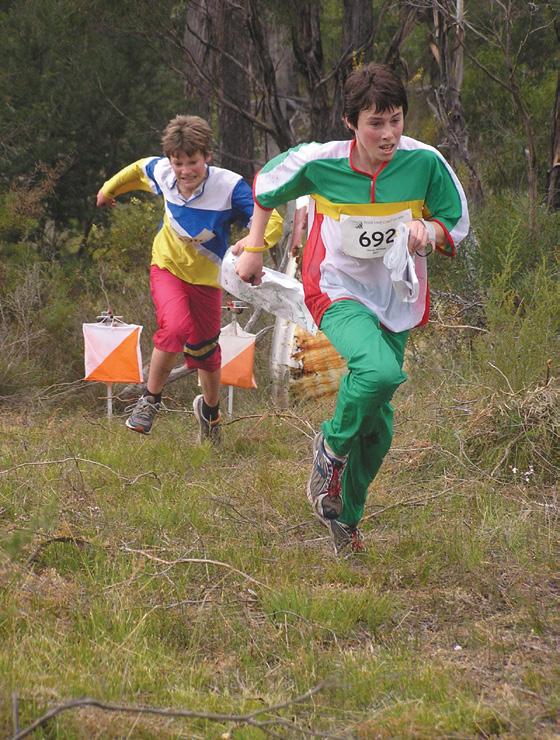
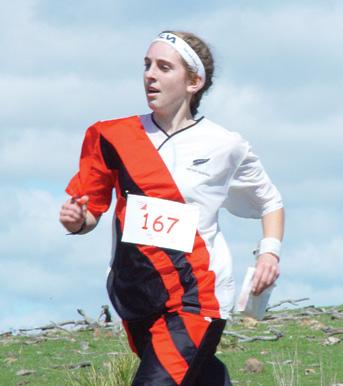
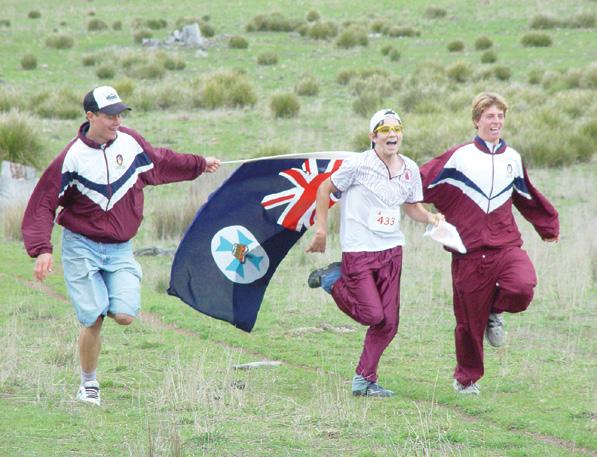

Oscar Phillips (Tas) heads off to the finish with Max Neve (Vic) close behind.
Queensland’s winning Senior Boys relay team: James Sheldon, Simon Mee Daniel Stott.
A colourful Rhys Challen from WA.
NSW’s Junior Girls relay team, second behind NZ but first Australian: Claire Darvodelsky, Emily Prudhoe and Thea Richardson.
Victoria’s Rob Fell looked spectacular jumping the fence, but he then stopped to help another competitor who had fallen.
Lizzie Ingham from New Zealand won the Senior Girls. Lizzie represented NZ at JWOC this year.
Heather Harding was first Australian in Senior Girls coming in third.
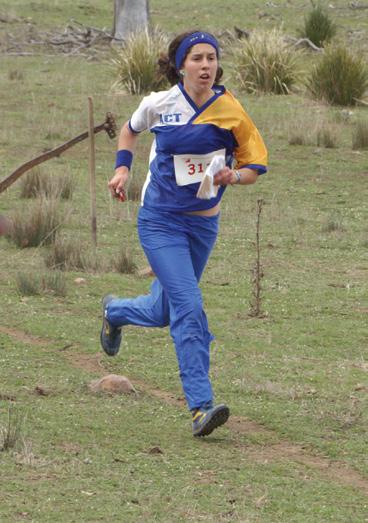
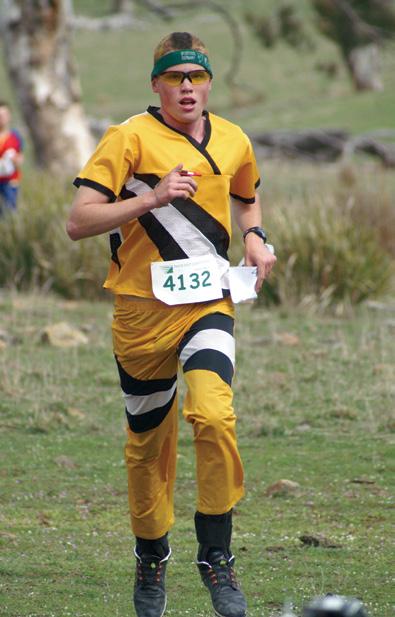


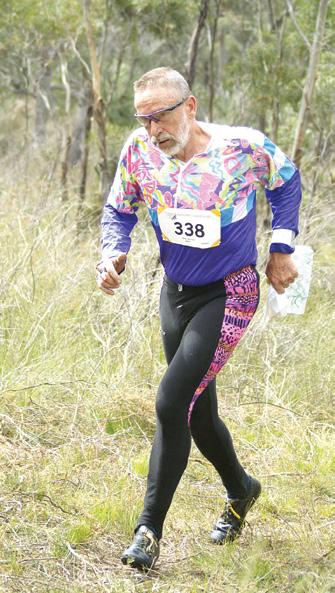
Hanny Allston was final leg runner in the Tasmanian W21 team with Grace Elson and Danielle Winslow that had a comprehensive victory at the Australian Relays. Wendy Read (QLD) and Kirsten Fairfax (VIC) work their way through the rocks during the Aus Long Champs at St Helens.
Dick Ogilvie (NSW) was part of the winning M60 relay team.
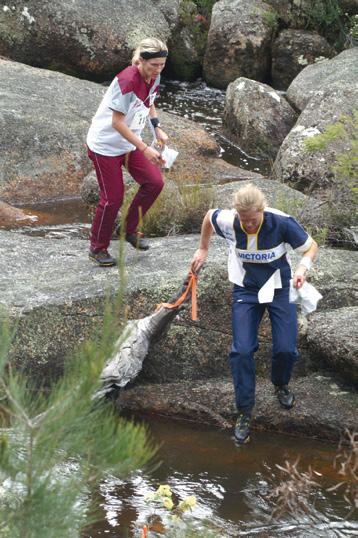
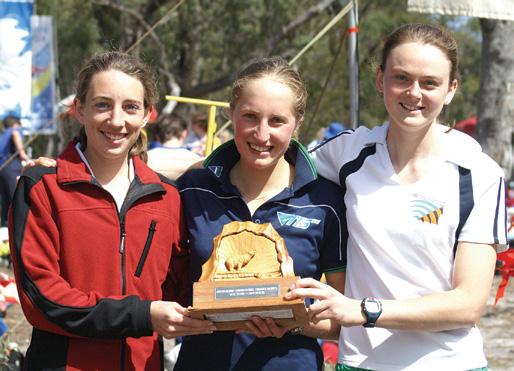
Erin’s impressive start to the Sprint Champs
Erin Post had a little problem at the start of the Australian Sprint title in Tasmania which Bob Mouatt managed to catch on camera. Despite this fall, she still came third in W17-20E, a mere 6 seconds from first. I wonder how long she was on the ground?
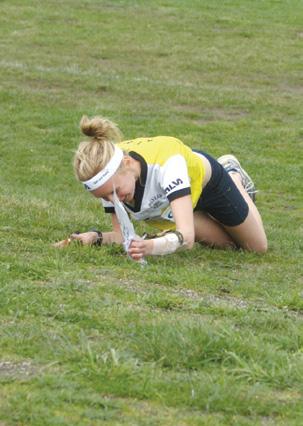
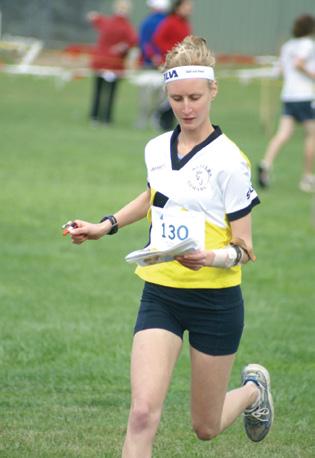


title outright, and did it by the convincing margin of six minutes, whilst Debbie Gale was even further ahead of the W55 field on home ground. Jenny Bourne was impressive in W45, not only against her own opposition but against the men on the same course (she beat Tarr and Lotty comfortably).
Ineka Booth, who has missed most of the year through illness and didn’t even make the ACT Schools team, showed that she is getting back towards her best form by winning W16, in a close contest with Nicola Peat and Bridget Anderson which was not settled until Booth jumped from third to first at the second-last control. W14 was just as close, Belinda Lawford edging out Krystal Neumann by 16 seconds in a duel where the pair were never separated by more than 31 seconds.
The New Zealanders dominated the junior boys. Simon Jager led four in the first five in M16, with Josh Roberts in second the only Australian to break the NZ dominance, whilst Toby Scott took advantage of the more technical terrain to win M14, as he had at the Australian Championships. NZ is building a generation of young orienteers of which we will hear much more, and it may well be in Dubbo in 2007 where we hear it.
Australian Relays, The Billabong, 2 October
THE Australian Relays are always a significant event in their own right, but, as in 2003, the situation in the National League added extra spice to the contest. To win the League, Victoria needed to beat the ACT in the two open classes by a combined three places, whilst in the juniors Tasmania needed to do likewise to Western Australia.
The first two legs of the relay looked like they had put the Cockatoos in a solid position. Five teams came in within two minutes on the first M21 leg, with the Victorian second team narrowly leading, and all contenders in the group except for South Australia (who were considered good place chances, at least, but came nowhere). That sorted itself out a bit on the second leg. Blair Trewin came through from fifth to put the Victorians in the lead, but the ACT and NSW were not far away: Rune Olsen was left to defend a 50-second lead over Grant Bluett, not impossible but difficult.
Meanwhile, the Cockatoos were holding it together in the women’s relay better than anyone expected, and after two legs, in a race where the Victorians were counting on beating the ACT by several places, they were struggling to beat them at all. Tasmania were running away with the race, as expected, through Danielle Winslow and Grace Elson, and South Australia were an unexpected second, but after a good first leg by Anna Danielsson, Heather Harding had held it together on the second leg, and ACT were in third, two minutes ahead of the Victorians, and it was looking like the best-case scenario for Victoria was a one-place win in both, not enough.
Any faint hopes the Victorians had completely disappeared at the final changeover when Clare Hawthorne took a men’s map by mistake. It disqualified her own team, and effectively ended the men’s chances as well; by the time a map was found for Olsen seven minutes had elapsed, and while he was credited for the time, he had lost the pack and any race rhythm. A ten-minute error at the first control absolutely finished it off. From that point on it was a formality, although Bluett and Hanny Allston both inflated their teams’ winning margins with dominant last legs, both several minutes faster than anyone else on the day. The ACT women passed South Australia on the last leg to take second behind the Tasmanians, whilst NSW and the Victorian second team filled the minor placings in M21. The second Victorian W21 team did provide a little consolation when their sixth place made sure of second in the League.
The junior division of the League wasn’t without its share of drama either. At the start of the day, most were conceding W20 to Western Australia, and Tasmania’s hopes rested on winning M20, where they were clear favourites, and hoping that WA would not be able to make the top four – a definite chance as the WA boys had struggled all week.
Like a lot of Orienteering scripts, this one wasn’t followed for much of the time. The WA girls indeed led after two legs, but not by much – the Tasmanians were only two minutes behind after a great second leg by Emma Warren, but it still looked an impossible task with their least experienced runner, Sonia Lawrie, up against Erin Post. The New Zealanders were well ahead of both but that was of only academic interest to most except the New Zealanders. On the other hand, with the useful addition of Ivan Komyshan to the team after an absence of a couple of years, the WA boys were doing better than anyone expected and actually led after two legs.
It looked like it was falling apart for WA in the early part of the last leg. Post lost 16 minutes at the fifth control, and by the time the teams reached the spectator control the Tasmanians had a useful lead. If they held it, it would mean the WA boys would have to come second, but they had dropped away as Louis Elson had taken control for Tasmania, and Rhys Challen had slipped into a three-way battle with Wes Dose (SA) and Evan Barr (Victoria) by the spectator control. The pressure was on, but Challen rose to the task, and was able to pull clear again for the second place that made sure of a historic League victory. As it turned out it wouldn’t have mattered; the Tasmanian girls mispunched on the last leg.
Even without the broader context that the League provided, several other classes had their moments. W16 was the best of them all, with five teams within four minutes and the win coming down to the last couple of controls. Queensland dominated the first two legs through Julia Sullivan and Bridget Anderson, but their sixminute lead was whittled away on the last leg, while at the same time Lara Haas was chasing down Ineka Booth. Haas gave the Tasmanians the lead with only three controls to go, but Booth was just a little too fast over the last two controls and gave the ACT a 20sec win.
No other class came down to a sprint finish. Several looked like they were going to, especially M55, where nine of the eleven teams were within four minutes of the lead after one leg, and the four leaders were still within a minute of each other after two. The situation called out for a big anchor leg and Greg Hawthorne delivered for the Tasmanians, eventually bringing his team home seven minutes ahead of the ACT and NSW. Mike Dowling was another Tasmanian to produce a big anchor leg, overturning a twominute deficit against the Victorians in M45 to win by five. Victoria also won easily in two relays which looked like they were going to be close after two legs: in W55 Kathy Liley’s last leg saw her team home after being five minutes down at the first change, whilst Janet Tarr was even more dominant in W60. At the other end of the closeness scale, the most dominant performances of the day, all by the only team in the class who were able to put three legs together, came from NSW in M60, Victoria in W45 and, to no-one’s surprise, New Zealand in M16.
Four orienteers win free ferry trips
The Spirit of Tasmania offered discount tickets on the ferries to Tasmania for the Australian Orienteering Championships. Those who booked for the ferries using their dedicated service went into a draw for free return tickets.
The lucky winners were:
Steve Hicks TTS Paul Hoopman TJU
Stephen Martin BGV Dick Olgivie URN
Congratulations to the winners – and many thanks to TTLine for their support.








